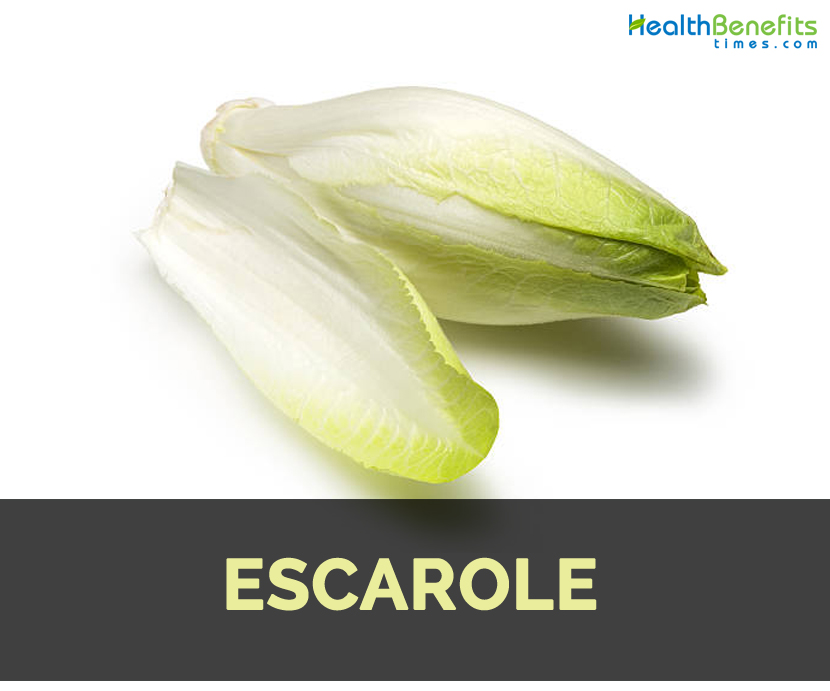 Escarole is a leafy green vegetable that belongs to the member of chicory family with endive, frisee and Belgian endive. It is also known as Bavarian endive, broad leafed endive, scarole having broad and curly green leaves and possess slightly bitter flavor. It could be consumed raw, sautéed, grilled and cooked in dishes. Escarole tastes less bitter in comparison to other chicories. The bitterness varies throughout the head with inner and lighter colored leaves less bitter than outer and darker green leaves. Inner leaves are added to salads and outer leaves are cooked in form of dishes.
Escarole is a leafy green vegetable that belongs to the member of chicory family with endive, frisee and Belgian endive. It is also known as Bavarian endive, broad leafed endive, scarole having broad and curly green leaves and possess slightly bitter flavor. It could be consumed raw, sautéed, grilled and cooked in dishes. Escarole tastes less bitter in comparison to other chicories. The bitterness varies throughout the head with inner and lighter colored leaves less bitter than outer and darker green leaves. Inner leaves are added to salads and outer leaves are cooked in form of dishes.
Escarole has wide and succulent stems and leaves which are more crumpled. It forms bunchy heads having narrow and ragged edged leaves which curls at the end. Center part is yellow to white. Garlic and cheese dressings pairs well with escarole’s flavor. Use it as a base for salads. Saute and serve it with seafood or meat. It has crisp and crunchy texture. It is available year round with peak season during summer and spring.
History of endive
Escarole is originated in Mediterranean but is inherent to Sicily. It is distributed widely all over the globe. It was used as vegetables in early days by Greeks, Romans and Egyptians. It was cultivated as early as 1548 in England. The origin in United States is traced back to early nineteenth century. The large rooted varieties were cultivated in 1826 in France.
Culinary uses
- Consume it raw or sautéed, grilled and cook in form of dishes.
- Inner leaves are preferably used in salads.
- Add it to pasta or soup recipes especially in Italian cuisine.
- Season the grilled escarole with salt pepper and serve it with vinaigrette and grated cheese on the top.
How to store
Cut the leaves and wrap it in paper towels to prevent from being damp. When escarole greens become wet, it rots much faster. They store much longer when it is in dry form. Then store it in an unsealed plastic bag. Place it in a refrigerator for 4 days.
How to choose
Avoid escarole having thick and tough outer leaves.
Health Benefits of Escarole
- Acne cure
Escarole is used to make juice found to be effective in treating skin problems. Combining escarole juice with natural juices helps to combat skin problems such as acne. Intake of endive letter juice helps in preventing outbreak.
- Cure for asthma
Combine the escarole extract with carrot juice and celery to aid lowering asthma attacks.
- Aids anemia
The mixture of endive, celery and parsley juice is found to be helpful for anemia patients as it acts as an effective blood tonic.
- Prevent cancer
Vitamin E prevents the onset of prostate gland cancer. Also vitamin A hinders pulmonary and mouth cancer. Escarole contains high content of fiber that maintains colon health. Calcium plays a crucial role in prevention of breast and ovarian cancers.
- Constipation relief
This green contains dietary fiber in it lowering irritation of bowel. It is effective when combined with apple or carrot juice.
- Eye health
Escarole juice is effective in treating eye complications such as cataracts, macular degeneration, glaucoma. The regular use of escarole lowers eye ailments.
- Gallbladder health
Combining escarole with other juices helps to promote bile secretion. It supports detoxification of liver managing cholesterol, cleanses blood, balance hormones and break down fats.
- Lose weight
Escarole has low count of calories making it best salad item. It is helpful for people who want to shed some pounds. Its use in form of juice or uncooked form helps to lower bodyweight.
- Packed with vitamins
Escarole comprises of all required vitamins and minerals that assist the bodily activities. It enhances immunity and prevents colon cancer, high blood pressure, diabetes, cardiac disease and depression. Overall it includes Vitamins such as B2, B1, K and C.
- Stimulates appetite
Taking in escarole juice before meal promote the urge for food. It acts as a laxative that deals with constipation. Nutritionists usually recommend including escarole to the diet for treating gastric and digestive issues. Add it to salads to experience appetite stimulating benefits.
- Treatment for Alzheimer’s
Studies revealed that escarole has adequate Vitamin E that prevents onset of Alzheimer’s disease.
- Stronger bones and teeth
Escarole has high content of calcium that promotes healthy and balanced bones as well as teeth and slows down the onset of osteoporosis.
- Supports digestion
Escarole has high content of dietary fibers that enhance digestion, relieves the bowel problems and wipe out kidney stones. It stimulates taste buds, activates production of enzymes and bile flow that promotes digestion. The proper digestion of food assists in proper absorption of nutrients from food. It is rich in fiber that eliminates waste through digestive tract.
- Healthy heart
Escarole is low in cholesterol levels and saturated fat making it preferable as heart healthy food clearing the heart ailments. Insulin manages LDL cholesterol levels and potassium regulates blood pressure.
- Healthy pregnancy
Escarole contains folate regarded to be crucial for preventing birth or fetal disorders during pregnancy.
https://www.youtube.com/watch?v=20bpPW98Otw
References:
https://www.thespruceeats.com/what-is-escarole-learn-about-this-leafy-green-995661
https://cals.arizona.edu/fps/sites/cals.arizona.edu.fps/files/cotw/Escarole.pdf
https://www.vegkitchen.com/5-leafy-greens-you-should-use-more-often/
https://www.natureword.com/tag/escarole/
https://medlicker.com/1101-endive

